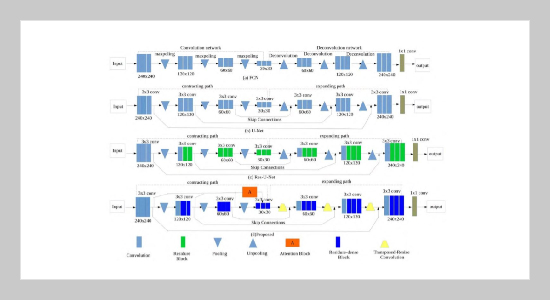REFERENCES
- [1]M Onoe. “Medical image processing,” information sciences, 175(3), pp.139-140, (2018). doi: 10.1016/j.ins.2005.01.005
- [2]Jiang, F., Grigorev, A., Rho, S. et al. “Medical image semantic segmentation based on deep learning,” Neural Comput & Applic, 29, pp. 1257–1265 (2018). doi:10.1007/s00521-017-3158-6
- [3]Gitta Kutyniok, Jackie Ma, Maximilian März. “Mathematical Methods in Medical Image Processing,” In: Sack I., Schaeffter T. (eds) Quantification of Biophysical Parameters in Medical Imaging. Springer, Cham. pp. 153-166, (2018). doi: 10.1007/978-3-319-65924-4_7
- [4]Maska M M, Mierzejewski M, Kochetov E A, et al. “Effective approach to the Nagaoka regime of the two-dimensional t-J model,” Physical review, 2012, 85(24):p.245113.1-245113.9. (2012). doi: 10.1103/PhysRevB.85.245113
- [5]Shoulin Yin, Ye Zhang, Shahid Karim. “Large Scale Remote Sensing Image Segmentation Based on Fuzzy Region Competition and Gaussian Mixture Model,” IEEE Access. 6, pp: 26069-26080. (2018). doi: 10.1109/ACCESS.2018.2834960
- [6]Lin Teng, Hang Li, Shoulin Yin, Yang Sun. “Improved krill group-based region growing algorithm for image segmentation,” International Journal of Image and Data Fusion. 10(4), pp. 327-341, (2019). doi: 10.1080/19479832.2019.1604574
- [7]Lin Teng, Hang Li. “CSDK: A Chi-square Distribution-Kernel method for Image De-noising Under the IoT Big Data Environment,” International Journal of Distributed Sensor Networks. 15(5), (2019). doi: 10.1177/1550147719847133
- [8]Shoulin Yin, Lei Meng and Jie Liu. “A New Apple Segmentation and Recognition Method Based on Modified Fuzzy C-means and Hough Transform,” Journal of Applied Science and Engineering. 22(2), pp. 349-354, (2019). doi: no
- [9]Zhao Y Q, Wang X F, Shih F Y, et al. “A LEVEL-SET METHOD BASED ON GLOBAL AND LOCAL REGIONS FOR IMAGE SEGMENTATION,” International Journal of Pattern Recognition and Artificial Intelligence, 26(1):p.1255004.1-1255004.16. (2012). doi: 10.1142/S021800141255004X
- [10]Yang, Y. Zhao, B. Wu and H. Wang, "A note on convex image segmentation model based on local and global intensity fitting energy," 2014 Southwest Symposium on Image Analysis and Interpretation, San Diego, CA, (2014), pp. 149-152, doi: 10.1109/SSIAI.2014.6806051
- [11]Lin Teng, Hang Li and Shahid Karim. “DMCNN: A Deep Multiscale Convolutional Neural Network Model for Medical Image Segmentation,” Journal of Healthcare Engineering, (2019). doi:10.1155/2019/8597606
- [12]Satish Viswanath, Daniel Palumbo, Jonathan Chappelow, et al. “Empirical evaluation of bias field correction algorithms for computer-aided detection of prostate cancer on T2w MRI,” Medical Imaging: Computer-aided Diagnosis. International Society for Optics and Photonics, (2015). doi: 1117/12.878813
- [13]Moës, N., Stolz, C. & Chevaugeon, N. “Coupling local and non-local damage evolutions with the Thick Level Set model,” Model. and Simul. in Eng. Sci. 1, 16 (2014). doi:10.1186/s40323-014-0016-2
- [14]An F P, Liu J E. “Medical Image Segmentation Algorithm Based on Optimized Convolutional Neural Network-Adaptive Dropout Depth Calculation,” Complexity, 2020(7):1-13, (2020). doi:10.1155/2020/1645479
- [15]Li Y, Wang Z. “A medical image segmentation method based on hybrid active contour model with global and local features,” Concurrency and Computation Practice and Experience, 2020(2), (2020). doi: 10.1002/cpe.5763
- [16]Karim Shahid, Ye Zhang, and Muhammad Rizwan Asif. "Image processing based proposed drone for detecting and controlling street crimes," IEEE 17th International Conference on Communication Technology (ICCT), pp. 1725-1730. IEEE, (2017). doi: 0.1109/ICCT.2017.8359925
- [17]Karim, S., Zhang, Y., Yin, S. et al. Impact of compressed and down-scaled training images on vehicle detection in remote sensing imagery. Multimed Tools Appl 78, 32565–32583 (2019). doi:1007/s11042-019-08033-x
- [18]Laghari, Asif Ali, Hui He, Muhammad Shafiq, and Asiya Khan. "Assessment of quality of experience (QoE) of image compression in social cloud computing," Multiagent and Grid Systems, vol. 14, no. 2, pp. 125-143 (2018). doi: no
- [19]Shoulin Yin, Ye Zhang and Shahid Karim. “Region search based on hybrid convolutional neural network in optical remote sensing images”, International Journal of Distributed Sensor Networks, 15(5), (2019). doi: 10.1177/1550147719852036
- [20]Teng Lin, Hang Li and Shoulin Yin. “Modified Pyramid Dual Tree Direction Filter-based Image De-noising via Curvature Scale and Non-local mean multi-Grade remnant multi-Grade Remnant Filter”, International Journal of Communication Systems. 31(16), (2018). doi: 10.1002/dac.3486
- [21]Paul B D, Axel V D G, Niklaus S, et al. “Automatic lesion detection and segmentation of 18F-FET PET in gliomas: A full 3D U-Net convolutional neural network study,” Plos One, 13(4):e0195798-. (2018). doi: 10.1371/journal.pone.0195798
- [22]Maeda, C. Ishikawa, S. Novianto, N. Tadehara and Y. Suzuki, "Rough and accurate segmentation of natural color images using fuzzy region-growing algorithm," Proceedings 15th International Conference on Pattern Recognition. ICPR-2000, Barcelona, Spain, pp. 638-641 vol.3, (2000), doi: 10.1109/ICPR.2000.903626.
- [23]Kede Ma, et al. “Multi-Exposure Image Fusion by Optimizing A Structural Similarity Index”, IEEE Transactions on Computational Imaging, 4(1), pp:60-72, 2018. doi: 10.1109/TCI.2017.2786138
- [24]Wang H W, Wu Y H, Hsieh J Y, et al. “Pediatric primary central nervous system germ cell tumors of different prognosis groups show characteristic miRNome traits and chromosome copy number variations,” BMC Genomics, 11(1):1-19. (2010). doi: 10.1186/1471-2164-11-132
- [25]Karim, Shahid, Imtiaz Ali Halepoto, Adnan Manzoor, Nazar Hussain Phulpoto,. "Vehicle detection in satellite imagery using maximally stable extremal regions." IJCSNS, vol. 18, no. 4, pp. 75- (2018). doi: no
- [26]Salem M, Valverde S, Cabezas M, et al. “Multiple Sclerosis Lesion Synthesis in MRI Using an Encoder-Decoder U-NET,” IEEE Access, 7:25171-25184. (2019). doi: 10.1109/access.2019.2900198
- [27]An F P, Liu J E. “Medical Image Segmentation Algorithm Based on Optimized Convolutional Neural Network-Adaptive Dropout Depth Calculation,” Complexity, 2020(7):1-13, (2020). doi: 10.1155/2020/1645479
- [28]Khosravanian A, Rahmanimanesh M, Keshavarzi P, et al. “Fuzzy local intensity clustering (FLIC) model for automatic medical image segmentation,” The Visual Computer, 2020(3). doi:10.1007/s00371-020-01861-1
- [29]Wenjun Yan, Yuanyuan Wang, Menghua Xia, et al. “Edge-Guided Output Adaptor: Highly Efficient Adaptation Module for Cross-Vendor Medical Image Segmentation,” Signal Processing Letters, IEEE, vol. 26, no. 11, pp. 1593-1597, Nov.( 2019), doi: 10.1109/LSP.2019.2940926









